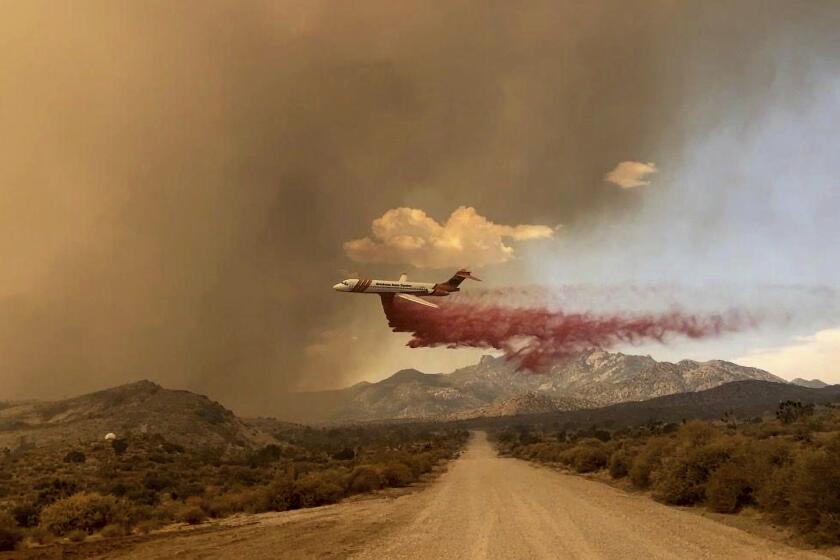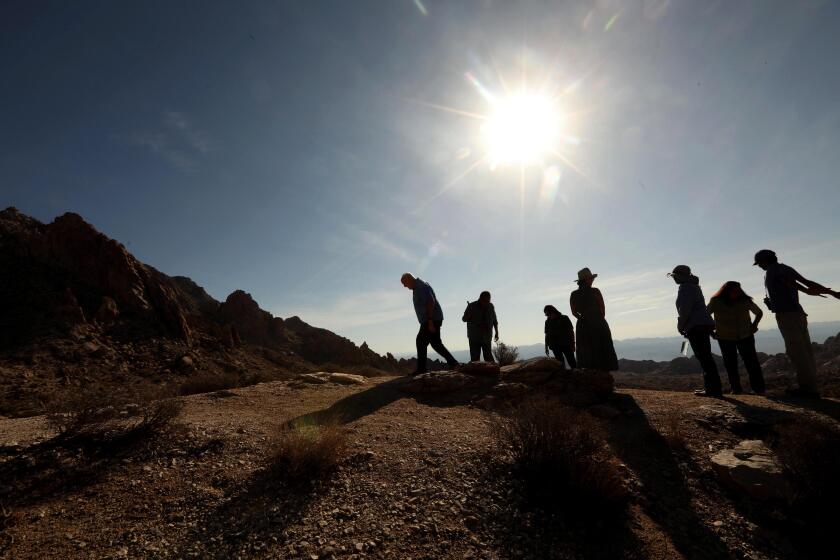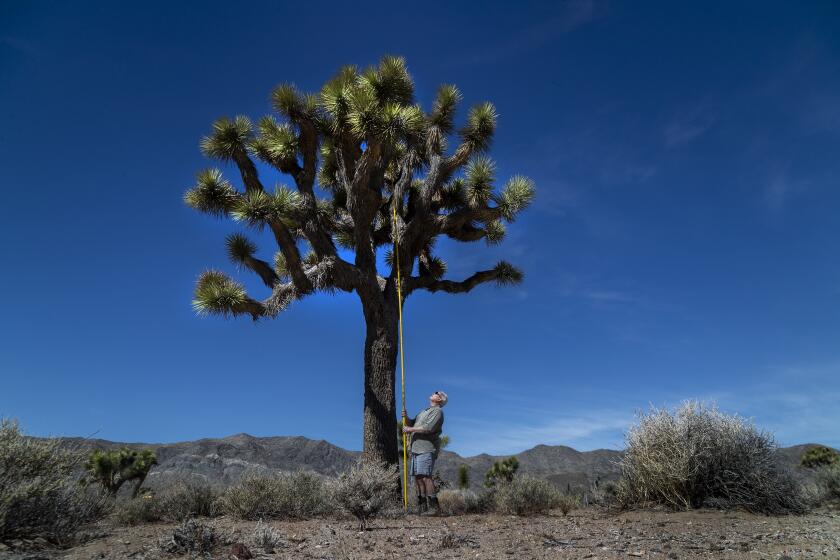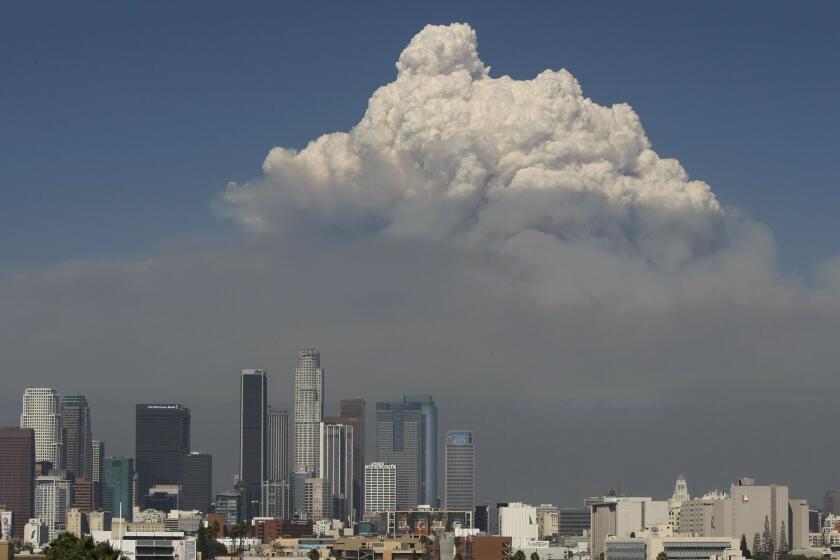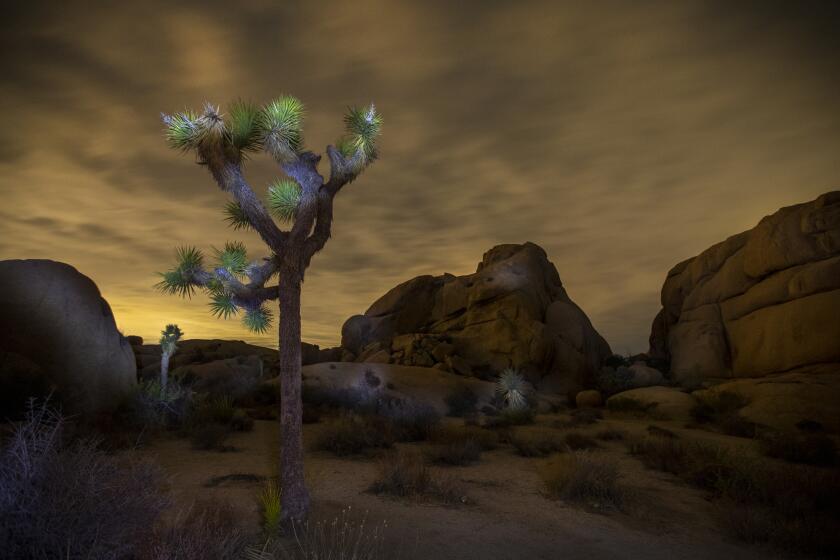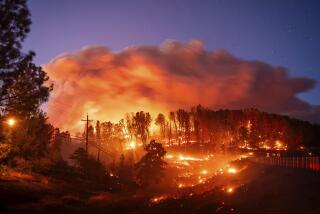As Joshua trees burn, massive wildfire threatens to forever alter Mojave Desert
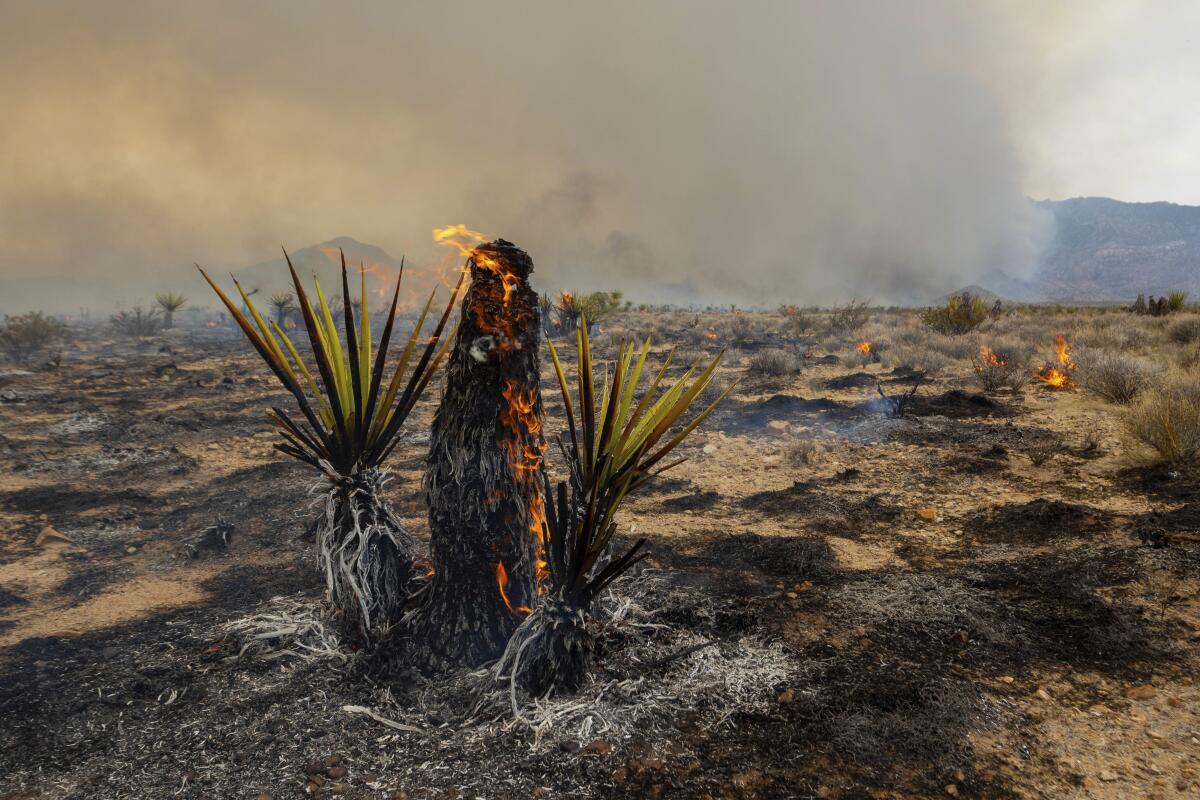
- Share via
As firefighters battle a massive wildfire in the eastern Mojave Desert, national park officials and ecologists are preparing for habitat losses that are likely to alter the landscape forever.
“We’ve lost a huge area of native vegetation,” said Debra Hughson, deputy superintendent for the Mojave National Preserve. “A lot of pinyon [pines], junipers gone forever, and a lot of the Joshua trees, likely.”
California’s largest wildfire of the year has grown to over 80,000 acres in the desert around the southern Nevada border, burning primarily in the national preserve, located in southeastern California. Aided by brief rain, crews made the first real inroads against the York fire after sunset Monday — reporting 23% containment by Tuesday morning — but officials remain worried the fragile landscape might never fully bounce back.
“Recovery is really not a meaningful term here in the desert because of the global change going on,” Hughson said. It will be nearly impossible for full forests to return from the scorched earth as they once were, and they are likely to be replaced by smaller shrubs and grasses, she said.
The York fire, which began in the Mojave National Preserve and spread into Nevada over the weekend, is uncontained.
Joshua trees, which grow nowhere else in the world besides the Mojave Desert, are particularly vulnerable to fire, with little natural defense.
“It’s going to be really hard to estimate the number of Joshua trees burned, but we do know there was a lot of them,” Hughson said.
The national preserve is home to more than 200 rare plants, and officials said it will take a while to determine the extent of the fire’s damage to those species.
As the fire has moved into southern Nevada, Hughson said she is also worried about a variety of sensitive plants and animals in that area. Officials said Monday the blaze had already reached part of the Avi Kwa Ame, or Spirit Mountain, National Monument, which just became federally designated this year after a push to better protect the sacred and environmentally distinct land. The monument’s land is home to Nevada’s largest known Joshua tree, designated as such just three years ago, state officials said.
For centuries, Native Americans have visited Avi Kwa Ame, or Spirit Mountain, to seek religious visions and give thanks for the bounty of the Earth.
“The fire behavior is extreme and uncertain,” Hughson said. She wasn’t sure what in southern Nevada was immediately at risk, and Bureau of Land Management officials did not respond to calls Tuesday.
Nevada forestry officials said Tuesday they’re concerned about the record-setting Joshua tree, as well as all local foliage, noting that the fire’s footprint appeared to be just six miles from site of the largest Joshua tree. Kacey KC , a state forester fire warden for the Nevada Division of Forestry, said their teams have alerted firefighters and the national monument officials about the special tree, asking for extra protection, if possible.
“It’s a vulnerable ecosystem,” KC said.
Firefighters made the most progress on the blaze so far after a night of lighter fire activity and about 15 minutes of a “wetting rain,” Marc Peebles, a spokesperson for the federal multiagency California Incident Management Team 13, said Tuesday.
“That doesn’t put the fire out or get us out of the woods, so to speak,” Peebles said. “It allows the firefighters to engage directly on the fire’s edge, taking out some of that heat.”
Until Tuesday, the fire had been burning completely uncontained since the flames were spotted Friday in the Mojave National Preserve.
Track wildfire origins, perimeters and air pollution with the L.A. Times California wildfires map.
Crews continue to battle the flames in a scorching heat — with temperatures reaching the desert’s typical summer highs above 100 degrees — along with high winds and low visibility. A monsoonal influence over the area has brought more strong gusts, which can stoke flames, along with the helpful moisture.
“The fire’s moderated a little bit [today], so the smoke levels have improved,” Peebles said, after visibility Monday was as limited as one mile.
The fire’s footprint grew by about 3,000 acres from Monday, still burning primarily in the eastern portion of the national preserve. The flames spread into Nevada over the weekend.
The national preserve last saw severe fire in 2020, when the Dome fire burned more than 40,000 acres across the southwestern California desert, burning though a different area than the York fire. That blaze destroyed an estimated 1 million Joshua trees, which crews and volunteers are still trying to bring back.
Ecologist Jim Cornett is as fascinated with California’s driest places as ever. But the signs of stress brought on by climate change terrify him.
In 2005, the Hackberry Complex fire burned more than 70,000 acres across the preserve. Many of the forests harmed in that fire 18 years ago still have not recovered, said Sierra Willoughby, a supervisory park ranger at the Mojave National Preserve.
As the York fire grew, Hughson said teams from the national preserve had been worried about white firs and Thorne’s buckwheat — the latter of which grows only in the preserve’s Fourth of July Canyon — but they determined the fire missed those habitats. Flames also avoided the Ivanpah Valley, home to a large population of the threatened desert tortoise.
“It stayed out of our best tortoise habitat, thankfully,” Hughson said.
Officials from the national preserve believe the fire likely destroyed some historic areas of the first homesteaders and miners in the area.
Firefighters and meteorologists look to a little-known metric called “mixing height” to understand how explosive wildfires spread in California without wind.
Fire crews are working with National Park Service experts to limit destruction of further important natural resources.
“Resource advisors are out there and they know all the areas that are sensitive or there are endangered species,” Peebles said.
Just 10 days before this wildfire was spotted in the New York Mountains area of the preserve, park officials warned of extreme fire risk for the federally protected desert, banning all open flames. Though large wildfires historically have not burned in California’s deserts, experts say the particularly wet winter and cool spring helped invasive grasses and underbrush flourish in the Mojave and Colorado deserts, providing ample fuel for such blazes as the vegetation dried out under soaring temperatures last month.
California has enacted the Western Joshua Tree Conservation Act, which is aimed at helping to ensure the survival of millions of the climate-threatened trees.
That cycle, Hughson said, could become even worse after the York fire.
“The thing about these kind of fires, it burns native vegetation,” Hughson said. “When you have these disturbed areas, it opens them up for weed invasion.”
Almost 400 personnel are assigned to the wildfire; its cause remains under investigation. However, officials have determined the flames started on private land within the preserve, said Stephanie Bishop, a National Park Service public information officer and a spokesperson for the York fire.
Meanwhile, the Bonny fire, burning in Riverside County southwest of Anza, has forced dozens to evacuate. It remained at about 2,300 acres as of Tuesday morning, with 40% containment — up from 20% on Monday, according to the California Department of Forestry and Fire Protection.
More to Read
Sign up for Essential California
The most important California stories and recommendations in your inbox every morning.
You may occasionally receive promotional content from the Los Angeles Times.
